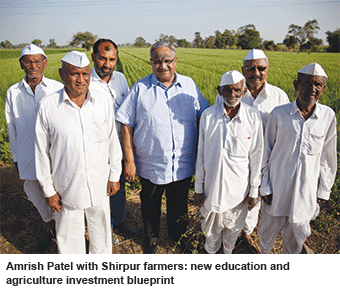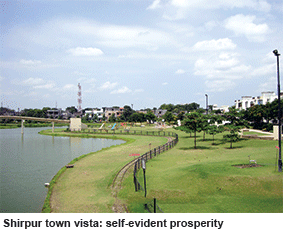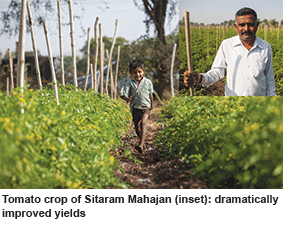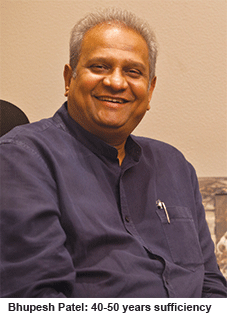Under the committed and sustained leadership of Congress MLC Amrish Patel, businessman, politician, educationist and water management champion, Shirpur taluka offers a blueprint for rural growth and upliftment countrywide Bharati Thakore & Dilip Thakore
 Although the Union Budget 2016-17, scheduled to be presented to Parliament and the public on February 29, is expected to provide some relief and hand-outs to Indian agriculture reeling under two successive years of drought, which has driven over 3,228 farmers in Maharashtra and 978 in Karnataka to suicide during the past year, the anticipated budgetary palliatives are unlikely to address, let alone correct the root causes of widespread rural under-development and neglect.
Although the Union Budget 2016-17, scheduled to be presented to Parliament and the public on February 29, is expected to provide some relief and hand-outs to Indian agriculture reeling under two successive years of drought, which has driven over 3,228 farmers in Maharashtra and 978 in Karnataka to suicide during the past year, the anticipated budgetary palliatives are unlikely to address, let alone correct the root causes of widespread rural under-development and neglect.
Way back in the 1950s when under newly-independent India’s charismatic first prime minister Jawaharlal Nehru, the nation adopted the Soviet inspired centrally-planned model of economic development, national savings and resources were canalised into developing public sector-led heavy industries, rather than into agriculture in which 70 percent of the population was engaged. This error was compounded by neglect of education and human capital development with an average of 3.5 percent of GDP (instead of the 6 percent recommended by the Kothari Commission in 1966) invested in education for the past 68 years.
Low annual rates of agriculture growth and widespread illiteracy spurred population growth which has tripled since independence, even as the capital-intensive heavy industry (and bank nationalisation) model proved to be an egregious failure, with the annual rate of GDP growth during the period 1950-91 stagnating at a mere 3.5 percent against the 5 percent global average.
Population pressure forced fragmentation of rural land-holdings, and an average trend growth rate of a mere 2 percent in rural India prompted mass migration of illiterate and under-educated people into the cities, and pervasive unemployment. Belatedly, wisdom has dawned upon the nation’s policy formulators (mercifully, the Planning Commission was dismantled in 2014) that priority has to be given to investment in agriculture and education, to regenerate and revive the Indian economy. 
“It’s a measure of the neglect of India’s agrarian economy that in 1950 when 70 percent of the population was residing in rural India, agriculture and allied activities contributed 56.5 percent of India’s GDP. Currently although 60 percent of the population is still in rural India, it contributes a mere 13 percent of GDP. Quite clearly agriculture and the rural economy have been severely neglected and deprived of investment. For inclusive development, rural-urban migration is not the solution. Village and small-town India need to become vibrant centres of education and growth and farming needs to recover its lost social prestige and respect. Unfortunately under the centrally-planned development model, rural India has become overly dependent upon government subsidies and handouts such as MNREGA which pays out wages without building durable assets, spurring inflation. India’s rural economy can only be revived through encouragement of village and small-town entrepreneurs who will create local jobs and eliminate the string of middlemen who expropriate the legitimate profit and surpluses of farmers. For rural regeneration we need free markets and private enterprise-led — rather than corruption-disabled government — initiatives,” says Sudheendra Kulkarni, the well-known IIT-Bombay alumnus, former journalist and (former) BJP ideologue, and currently Mumbai-based director of the Observer Research Foundation, a highly-respected think tank (estb. 1990).
Quite clearly, if the scale of deprivation in the hinterland of the Indian economy — 53 percent of children dropping out of school before completion of primary education, 48 percent of children stunted because of severe malnutrition and a poverty line drawn by the erstwhile Planning Commission at a mere Rs.30 per capita per day — is taken into account, post-independence India’s neta-babu-led rural development model has been a terrible failure. To this dismal scenario, if one adds the almost total absence of a law, order and justice machinery which has transformed the rural bureaucracy into a giant kleptocracy, it’s plainly evident that a new free market and native private enterprise blueprint is required for rural renewal.
.gif) This pathetic condition of large swathes of village India perhaps explains why policy formulators, economists, development scientists and politicians with a vested interest in re-election, are converging upon Shirpur town and taluka (sub-district, pop. 300,000) in northern Maharashtra, a three-hour drive down the newly asphalted and broadened NH 3 from the fast-industrialising city of Indore in Madhya Pradesh and equidistant from Nashik. Thanks to a home-grown public-private enterprise model, Shirpur town and its surrounding 72 villages have transformed into arguably India’s most prosperous taluka. Under the committed and sustained leadership of Congress MLC Amrish Patel, a successful businessman, politician, educationist and water management champion, Shirpur taluka offers a roadmap for rural growth and upliftment countrywide.
This pathetic condition of large swathes of village India perhaps explains why policy formulators, economists, development scientists and politicians with a vested interest in re-election, are converging upon Shirpur town and taluka (sub-district, pop. 300,000) in northern Maharashtra, a three-hour drive down the newly asphalted and broadened NH 3 from the fast-industrialising city of Indore in Madhya Pradesh and equidistant from Nashik. Thanks to a home-grown public-private enterprise model, Shirpur town and its surrounding 72 villages have transformed into arguably India’s most prosperous taluka. Under the committed and sustained leadership of Congress MLC Amrish Patel, a successful businessman, politician, educationist and water management champion, Shirpur taluka offers a roadmap for rural growth and upliftment countrywide.
To visitors accustomed to the dry, dusty towns and villages of rural India, the relative prosperity of Shirpur and its 72 villages, is self-evident. As one enters the taluka, green, well-irrigated fields are the rule rather than exception, roads are pothole free and well-lit at night, and open drains which characterise small-town and village India are a rare sight. The people are well-clothed and well-fed, the town is properly laid out presenting painted and spaced out residential homes with adequate setback.
Every street corner boasts neat and clean school and college campuses of the Shirpur Education Society (SES), an education trust established by Patel in 1990. Patel is also managing trustee of the heavyweight Mumbai-based Shri Vile Parle Kelavani Mandal (SVKM) trust which has promoted 35 education institutions in Mumbai, Shirpur, Bangalore and Hyderabad. Among them: eight K-12 schools and 27 professional colleges, including the Narsee Monjee Institute of Management Studies (NMIMS), which was conferred deemed university status in 2003 and is routinely ranked among the country’s top B-schools. Currently SVKM education institutions in Mumbai have an aggregate of 40,000 students mentored by 1,000 teachers on their muster rolls.
The Patel family relocated from Indore to Shirpur in 1951 following Amrish’s father Rasikbhai’s decision to set up a petrol pump and petro-products trading firm in Shirpur. The family with four children settled down and struck roots there. The Patel community is famed for entrepreneurship, and something about Shirpur with its two rivers and easy distance from the market towns of Indore and Nashik appealed to Rasikbhai.
With cotton easily available in the nearby Dhule district, in 1998 Amrish promoted a weaving and finishing company named Priyadarshini Cooperative Spinning Mill Ltd. Since then this company has grown into a large and successful enterprise with a capacity of 139,000 spindles, and produces 18,250 tonnes of fine textiles annually for export to Europe and China. The company employs 3,000 workers whose average wage is Rs.9,000 per month. Today the company is the hub of Priyadarshini Textiles Park which hosts seven textile and allied firms employing 10,000 workers. 
But although Rasikbhai and his family settled in Shirpur, the town lacked adequate education facilities and young Amrish was packed off to Ahmedabad and Ujjain to complete his higher secondary education. This separation from his family impacted him deeply. In 1990 he promoted the Shirpur Education Society and his first primary-secondary school with an initial batch of 60 students. Since then, SES institutions have grown to 17 pre-primary, eight K-12 schools, seven ashram (rural boarding) schools and four professional education colleges, with an aggregate enrolment of 30,000 students and 900 teachers/ faculty. In 2007, Patel persuaded the board of trustees of SVKM to establish a Shirpur campus of the Narsee Monjee University, which currently has an enrolment of 1,857 students mentored by 125 faculty.
Moreover, unlike most businessmen who tend to shy away from politics, determined to attack poverty, illiteracy and backwardness in the challenging environment of his adopted town and taluka, Amrish Patel joined the Congress party in 1984 and was elected to the Shirpur Municipal Corporation for the first time on May 15, 1985. In 1990 he was elected a member of the Maharashtra legislative assembly and has served as MLA (Shirpur constituency) for four terms, including a brief stint (2002-04) as Maharashtra’s education minister.
“The people of Shirpur have reposed all their faith and confidence in me by repeatedly electing me to the municipal council and legislative assembly. Shirpur is my home; I have invested all my efforts and energy to wipe out the curse of illiteracy and poverty from this region. And today I’m proud to say that this is the most literate and prosperous taluka in India’s most industrial state,” says Patel with justifiable pride.
According to Patel, the Shirpur Development Model is built on four “foundational pillars”, viz, quality education accessible to all; water management and conservation; employment generation and environment sustainability.
 Education. Despite being a life-long member of the Congress party, Patel was — and remains — unimpressed by its socialist ideological baggage and saw nothing wrong in promoting private pre-primary to higher education institutions, when he witnessed that government institutions and administrators were “unaccountable” and not delivering real education. Therefore instead of taking on the herculean task of attempting to reform the teacher-centric government system, he borrowed money from his father to constitute the Shirpur Education Society in 1990. Since then the trust (endowment corpus: Rs.108 crore) has promoted 17 pre-primary, eight K-12 schools, seven ashram schools and four colleges with an aggregate enrolment of 30,000 students mentored by 900 teachers/faculty.
Education. Despite being a life-long member of the Congress party, Patel was — and remains — unimpressed by its socialist ideological baggage and saw nothing wrong in promoting private pre-primary to higher education institutions, when he witnessed that government institutions and administrators were “unaccountable” and not delivering real education. Therefore instead of taking on the herculean task of attempting to reform the teacher-centric government system, he borrowed money from his father to constitute the Shirpur Education Society in 1990. Since then the trust (endowment corpus: Rs.108 crore) has promoted 17 pre-primary, eight K-12 schools, seven ashram schools and four colleges with an aggregate enrolment of 30,000 students mentored by 900 teachers/faculty.
To encourage students to enroll, scholarships of up to 75 percent are liberally awarded to needy students. “Liberal scholarships are socially beneficial because it makes well-educated labour and managers available to local industry, which gains by way of high productivity in goods and services. Therefore investment in education can never be a losing proposition and is the bedrock of the Shirpur development model,” says Patel.
SES institutions in Shirpur taluka have also had the beneficial impact of raising the standards of municipal and zilla parishad (village) schools which are neat and tidy and report good teacher and student attendance. As a consequence, of the total population of 75,000 in Shirpur town, 35,000 are attending classes in schools and colleges.
Water Management & Conservation. Maharashtra (pop. 112 million) has suffered severe droughts in the past two years and reports the highest number of annual farm suicides (3,228 in 2015) countrywide, as debt-laden farmers heavily dependent upon the monsoons have been driven to despair. However even though farmers across the state have been reeling under the failure of two successive monsoons in north Maharashtra in particular, in Shirpur taluka farmers have harvested two crops — in some cases even three — as usual. Patel attributes this phenomenon to a scientific and far-sighted paani aadva ani paani jirva (‘break flow and seep ground water’) programme conceptualised and implemented by the municipal council and state government with the help of expert geologist Suresh Khanapurkar, former director of the Dhule-based Groundwater Survey and Development Agency (GSDA). Under the programme, check (small) dams have been built on rivulets of the Arunvati and Tapi rivers which flow through the taluka. The check dams break the flow of water during monsoons, allowing it to seep into the soil.
“The specialty of check dams — when built correctly — is that they slow the flow of the rivulets and divert eight times the flow as underground water for farms in the region. We were able to persuade the state government to help us build check dams which enable the groundwater tables of farms to rise. Admittedly governments have built check dams in the past but unprofessionally and unscientifically, therefore they failed. But in our case they have been very successful,” says Patel. 
High groundwater tables of farmland in Shirpur taluka enable water to be pumped out year round, and its beneficial impact is evidenced by the high yields that farmers in the region record. For instance, the average yield of cotton is 3,000 kg per hectare against the national average of 489 kg. Although average per-hectare yields obtained by Shirpur’s farmers for wheat, jowar and sugarcane are not recorded, visual and anecdotal evidence indicates they are substantially higher than the national averages. With the taluka served by over 2,000 check dams that ensure year round water supply, despite receiving scanty rainfall for two consecutive years, farmers in the region have enough water supply to plant two, sometimes three crops per year.
“I have been growing tomatoes, vegetables, sugarcane and wheat for over 40 years on my 50 acre farm and have suffered severe water shortages and very low income in the past. But ever since the check dams were constructed, yields have improved dramatically. I now earn between Rs.12-15 lakh per annum and the value of my land has also gone up from Rs.40,000 per acre in 1980-90 to Rs.2 crore currently. I can afford to send my children to good schools and our quality of life has improved. I am now proud to be a farmer contributing to the life and well-being of my fellow citizens,” says Sitaram Dagdu Mahajan, a local farmer interviewed by EducationWorld.
In addition, Shirpur township boasts perhaps India’s most modern water purification system. Under Patel’s presidency of the municipal council and advocacy in the legislative assembly, pipelines have been constructed from the Tapi river to bring potable drinking water to the town. A fully automated water purification system from the United States, which also electronically monitors the town’s water supply, is currently being installed.
“Residents were suffering an acute shortage of drinking water a decade ago. Now Shirpur receives 600,000 litres of water per household daily. According to our calculations, even allowing for the normative growth of population, there will be enough potable drinking water in Shirpur taluka for the next 40-50 years,” says Bhupesh Patel, Amrish’s brother and incumbent president of the Shirpur Municipal Corporation, who has been instrumental in persuading the council and the state government to contribute grants aggregating Rs.40 crore for installing water distribution and purification systems.
Employment Generation. It’s widely acknowledged that for Indian agriculture to prosper, the fragmentation of rural holdings needs to be reversed through rural-urban migration and generation of employment in small-town India. But with GDP stuck in the rut of so-called Hindu rate of growth (3.5 percent per year) for over four decades (1950-91) during which the country’s population tripled, this desideratum has remained a mirage.
Only latterly, after the partial liberalisation and deregulation of the economy in 1991 has the annual GDP growth rate doubled to 7 percent plus and job creation in industry picked up, although nowhere near the 12 million jobs that need to be created annually. Nevertheless Shirpur town and taluka, driven by education and a spirit of entrepreneurship under Amrish Patel’s leadership is an exception.
 The Shirpur Municipal Council has encouraged the inflow of investment into education and industry, which has created non-farm employment for people of the region. Under the leadership of the Priyadarshini Co-op Spinning Ltd, promoted by Amrish Patel and his brothers, a substantial textiles industry has developed in Shirpur, centred in the 1,000-acre Priyadarshini Textile Park which hosts seven yarn, textiles and allied enterprises employing 10,000 people. The company’s textile factories are wholly contemporary with machinery from Germany and Japan, and export raw and finished textiles and garments to Canada, USA, Japan and China among other countries.
The Shirpur Municipal Council has encouraged the inflow of investment into education and industry, which has created non-farm employment for people of the region. Under the leadership of the Priyadarshini Co-op Spinning Ltd, promoted by Amrish Patel and his brothers, a substantial textiles industry has developed in Shirpur, centred in the 1,000-acre Priyadarshini Textile Park which hosts seven yarn, textiles and allied enterprises employing 10,000 people. The company’s textile factories are wholly contemporary with machinery from Germany and Japan, and export raw and finished textiles and garments to Canada, USA, Japan and China among other countries.
Moreover with national highways and improved road connectivity, there are signs of Shirpur emerging as a hub of agriculture machinery and food processing industries in the near future. “The Shirpur Municipal Council receives numerous proposals to establish industrial and other businesses in this region. We are committed to improving the ease of doing business and I have no doubt this region will experience growth in industry and business activity with strong linkages with the rural hinterland,” says Amrish Patel.
Environment Sustainability. Given Shirpur taluka’s highly educated population which has adopted successful water management and conservation practices enabling its farmers to record enviably high farm yields, it’s hardly surprising that its municipal council and village panchayats have embraced ecofriendly sustainable farming practices such as recycling crop waste, soil regeneration through reduction of chemical fertilizers to the bare minimum and adoption of new organic farming practices. Moreover the Shirpur municipal council, village panchayats and zilla parishads are implementing a massive reafforestation drive involving the planting of 150,000 neem trees which have soil regeneration and therapeutic properties. This project began seven years ago, and has begun to contribute to the taluka’s already green and leafy environment and clean air.
Undoubtedly, over the past six decades since Rasikbhai Patel fortuitously chose to strike roots in Shirpur, his sons led by Amrish have engineered a unique private education-driven socio-economic development model which has transformed the dry and dusty town and hinterland which they adopted as their home, into an oasis of high literacy and prosperity. The Shirpur development model offers hope to India’s hundreds of thousands of small towns and talukas, and is a live example of how quality pre-primary to collegiate education can clear the ground for adoption of best farming practices, and attract business investment in newly prosperous communities. 
In this connection it is important to note that Amrish Patel didn’t — as is normative in Indian business and industry — shun involvement with politics. On the contrary, he was quick to realise that political power and influence makes it easy to implement pro-people development policies and practices.
“It’s not true that political parties and politicians are averse to social and economic development. When they see that you have the full support of your constituency, they are more inclined to listen to your proposals and plans. In a large and resources deficient country, it’s very difficult to implement development projects without government cooperation. The success of the Shirpur model is to a great extent attributable to the fact that we have been able to explain our vision and proposals to people in government. Political influence combined with the spirit of self-help, education, cooperation and determination are the success factors behind the Shirpur development model which should — and can be — replicated countrywide,” says Patel.
To these factors add committed leadership.